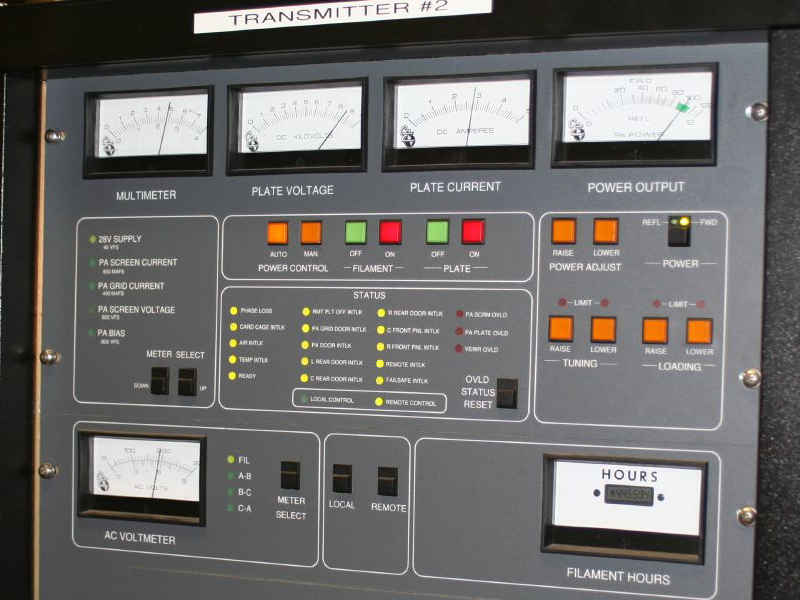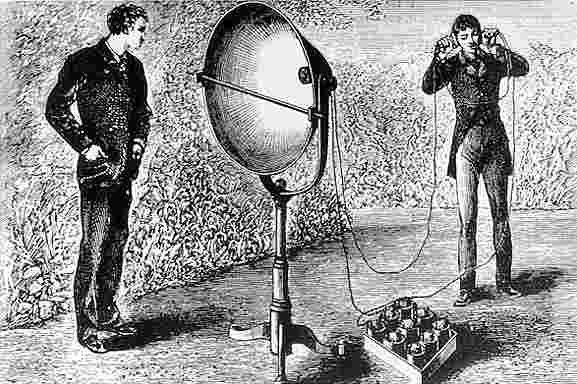|
Remote Infrared Audible Signage
Remote infrared audible signage (RIAS) was developed by Smith-Kettlewell Eye Research Institute (as Talking SignsR) so that print-disabled people, such as those that are blind or have low-vision, or are illiterate, foreign, or visually impaired, would be able to access the same type of information available through textual print signs within the built environment. It consists of infrared transmitters repeatedly sending encoded spoken versions of the contents of the sign through wireless communication. An early version in 1979 called "Talking Lights" has been successfully upgraded/marketed commercially as "Talking Signs" which are being globally installed. An associated handheld or glasses-mounted IR receiver is directionally sensitive to a direct, line-of-sight infrared light beam and orients the person by giving more positive feedback when the sign is being pointed to directly and is close. The system has been tested and works effectively in both interior and exterior settings ... [...More Info...] [...Related Items...] OR: [Wikipedia] [Google] [Baidu] |
Smith-Kettlewell Eye Research Institute
The Smith-Kettlewell Eye Research Institute is a nonprofit research institute in San Francisco, California, with a focus on vision science and rehabilitation engineering. It was founded in 1959 by Arthur Jampolsky and Alan B. Scott, when some members of Stanford University's Ophthalmology Department elected to stay in San Francisco rather than move to Palo Alto, California, Palo Alto. Scientific contributions The Institute did early experiments in sensory substitution, especially the substitution of tactile information for visual information to help blind people navigate and other methods to obtain accessible technology. This research is often performed by scientists who are blind, such as Josh Miele. The institute's use of botulinum toxin in humans as a Botulinum toxin therapy of strabismus, therapy to treat strabismus. This initial therapeutic use led to later cosmetic use in Botox. Other impactful work involved Anthony Norcia's study of vision in infants and Erich Sutter's in ... [...More Info...] [...Related Items...] OR: [Wikipedia] [Google] [Baidu] |
Blindness
Visual or vision impairment (VI or VIP) is the partial or total inability of visual perception. In the absence of treatment such as corrective eyewear, assistive devices, and medical treatment, visual impairment may cause the individual difficulties with normal daily tasks, including reading and walking. The terms ''low vision'' and ''blindness'' are often used for levels of impairment which are difficult or impossible to correct and significantly impact daily life. In addition to the various permanent conditions, fleeting temporary vision impairment, amaurosis fugax, may occur, and may indicate serious medical problems. The most common causes of visual impairment globally are uncorrected refractive errors (43%), cataracts (33%), and glaucoma (2%). Refractive errors include near-sightedness, far-sightedness, presbyopia, and astigmatism (eye), astigmatism. Cataracts are the most common cause of blindness. Other disorders that may cause visual problems include age-related macular ... [...More Info...] [...Related Items...] OR: [Wikipedia] [Google] [Baidu] |
Infrared
Infrared (IR; sometimes called infrared light) is electromagnetic radiation (EMR) with wavelengths longer than that of visible light but shorter than microwaves. The infrared spectral band begins with the waves that are just longer than those of red light (the longest waves in the visible spectrum), so IR is invisible to the human eye. IR is generally (according to ISO, CIE) understood to include wavelengths from around to . IR is commonly divided between longer-wavelength thermal IR, emitted from terrestrial sources, and shorter-wavelength IR or near-IR, part of the solar spectrum. Longer IR wavelengths (30–100 μm) are sometimes included as part of the terahertz radiation band. Almost all black-body radiation from objects near room temperature is in the IR band. As a form of EMR, IR carries energy and momentum, exerts radiation pressure, and has properties corresponding to both those of a wave and of a particle, the photon. It was long known that fires e ... [...More Info...] [...Related Items...] OR: [Wikipedia] [Google] [Baidu] |
Transmitters
In electronics and telecommunications, a radio transmitter or just transmitter (often abbreviated as XMTR or TX in technical documents) is an electronic device which produces radio waves with an antenna with the purpose of signal transmission to a radio receiver. The transmitter itself generates a radio frequency alternating current, which is applied to the antenna. When excited by this alternating current, the antenna radiates radio waves. Transmitters are necessary component parts of all electronic devices that communicate by radio, such as radio (audio) and television broadcasting stations, cell phones, walkie-talkies, wireless computer networks, Bluetooth enabled devices, garage door openers, two-way radios in aircraft, ships, spacecraft, radar sets and navigational beacons. The term ''transmitter'' is usually limited to equipment that generates radio waves for communication purposes; or radiolocation, such as radar and navigational transmitters. Generators of radi ... [...More Info...] [...Related Items...] OR: [Wikipedia] [Google] [Baidu] |
Wireless
Wireless communication (or just wireless, when the context allows) is the transfer of information (''telecommunication'') between two or more points without the use of an electrical conductor, optical fiber or other continuous guided transmission medium, medium for the transfer. The most common wireless technologies use radio waves. With radio waves, intended distances can be short, such as a few meters for Bluetooth, or as far as millions of kilometers for NASA Deep Space Network, deep-space radio communications. It encompasses various types of fixed, mobile, and portable applications, including two-way radios, Mobile phone, cellular telephones, personal digital assistants (PDAs), and wireless networking. Other examples of applications of radio ''wireless technology'' include Global Positioning System, GPS units, garage door openers, wireless Mouse (computing), computer mouse, Keyboard (computing), keyboards and Headset (audio), headsets, headphones, radio receivers, satelli ... [...More Info...] [...Related Items...] OR: [Wikipedia] [Google] [Baidu] |
Line-of-sight Propagation
Line-of-sight propagation is a characteristic of electromagnetic radiation or acoustic wave propagation which means waves can only travel in a direct visual path from the source to the receiver without obstacles. Electromagnetic transmission includes light emissions traveling in a straight line. The rays or waves may be diffracted, refracted, reflected, or absorbed by the atmosphere and obstructions with material and generally cannot travel over the horizon or behind obstacles. In contrast to line-of-sight propagation, at low frequency (below approximately 3 MHz) due to diffraction, radio waves can travel as ground waves, which follow the contour of the Earth. This enables AM radio stations to transmit beyond the horizon. Additionally, frequencies in the shortwave bands between approximately 1 and 30 MHz, can be refracted back to Earth by the ionosphere, called skywave or "skip" propagation, thus giving radio transmissions in this range a potentially global reach ... [...More Info...] [...Related Items...] OR: [Wikipedia] [Google] [Baidu] |
Alexander Graham Bell
Alexander Graham Bell (; born Alexander Bell; March 3, 1847 – August 2, 1922) was a Scottish-born Canadian Americans, Canadian-American inventor, scientist, and engineer who is credited with patenting the first practical telephone. He also co-founded the AT&T Corporation, American Telephone and Telegraph Company (AT&T) in 1885. Alexander Melville Bell, Bell's father, grandfather, and brother had all been associated with work on elocution and speech, and both his mother and wife were deaf, profoundly influencing Bell's life's work. His research on hearing and speech further led him to experiment with hearing devices, which eventually culminated in his being awarded the first United States patent law, U.S. patent for the telephone, on March 7, 1876. Bell considered his invention an intrusion on his real work as a scientist and refused to have a telephone in his study. Many other inventions marked Bell's later life, including ground-breaking work in Free-space optical commun ... [...More Info...] [...Related Items...] OR: [Wikipedia] [Google] [Baidu] |
Photophone
The photophone is a telecommunications device that allows transmission of speech on a beam of light. It was invented jointly by Alexander Graham Bell and his assistant Charles Sumner Tainter on February 19, 1880, at Bell's laboratory at 1325 L Street in Washington, D.C. Both were later to become full associates in the Volta Laboratory Association, created and financed by Bell. On June 3, 1880, Bell's assistant transmitted a wireless voice telephone message from the roof of the Franklin School to the window of Bell's laboratory, some 213 meters (about 700 ft.) away.Carson 2007, pg. 76–78Mims 1982, p. 11. Bell believed the photophone was his most important invention. Of the 18 patents granted in Bell's name alone, and the 12 he shared with his collaborators, four were for the photophone, which Bell referred to as his "greatest achievement", telling a reporter shortly before his death that the photophone was "the greatest invention haveever made, greater than the tele ... [...More Info...] [...Related Items...] OR: [Wikipedia] [Google] [Baidu] |
Assistive Technology
Assistive technology (AT) is a term for assistive, adaptive, and rehabilitative devices for Disability, people with disabilities and the elderly. Disabled people often have difficulty performing activities of daily living (ADLs) independently, or even with assistance. ADLs are self-care activities that include toileting, mobility (ambulation), eating, bathing, dressing, grooming, and personal device care. Assistive technology can ameliorate the effects of disabilities that limit the ability to perform ADLs. Assistive technology promotes greater independence by enabling people to perform tasks they were formerly unable to accomplish, or had great difficulty accomplishing, by providing enhancements to, or changing methods of interacting with, the technology needed to accomplish such tasks. For example, wheelchairs provide independent mobility for those who cannot walk, while assistive eating devices can enable people who cannot feed themselves to do so. Due to assistive technology, ... [...More Info...] [...Related Items...] OR: [Wikipedia] [Google] [Baidu] |
Accessible Information
Holevo's theorem is an important limitative theorem in quantum computing, an interdisciplinary field of physics and computer science. It is sometimes called Holevo's bound, since it establishes an upper bound to the amount of information that can be known about a quantum state (accessible information). It was published by Alexander Holevo in 1973. Statement of the theorem Suppose Alice wants to send a classical message to Bob by encoding it into a quantum state, and suppose she can prepare a state from some fixed set \, with the i-th state prepared with probability p_i. Let X be the classical register containing the choice of state made by Alice. Bob's objective is to recover the value of X from measurement results on the state he received. Let Y be the classical register containing Bob's measurement outcome. Note that Y is therefore a random variable whose probability distribution depends on Bob's choice of measurement Measurement is the quantification of attributes of an ... [...More Info...] [...Related Items...] OR: [Wikipedia] [Google] [Baidu] |
Speech Synthesis
Speech synthesis is the artificial production of human speech. A computer system used for this purpose is called a speech synthesizer, and can be implemented in software or hardware products. A text-to-speech (TTS) system converts normal language text into speech; other systems render symbolic linguistic representations like phonetic transcriptions into speech. The reverse process is speech recognition. Synthesized speech can be created by concatenating pieces of recorded speech that are stored in a database. Systems differ in the size of the stored speech units; a system that stores phones or diphones provides the largest output range, but may lack clarity. For specific usage domains, the storage of entire words or sentences allows for high-quality output. Alternatively, a synthesizer can incorporate a model of the vocal tract and other human voice characteristics to create a completely "synthetic" voice output. The quality of a speech synthesizer is judged by its similar ... [...More Info...] [...Related Items...] OR: [Wikipedia] [Google] [Baidu] |








